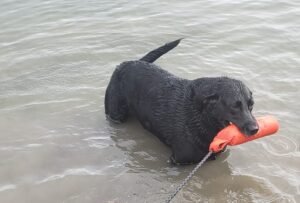An article from WWA’s Doctor’s Orders
 By Dr. K.C. Brooks, an avid waterfowler, dog lover and practicing veterinarian at Lodi Veterinary Care.
By Dr. K.C. Brooks, an avid waterfowler, dog lover and practicing veterinarian at Lodi Veterinary Care.
This article originally appeared in Wisconsin Waterfowl Association’s July, 2022 eNewsletter.
Summertime has officially arrived and the temperatures have finally heated up. If you are like me, my mind has already shifted to getting ready for the fall hunting season. That means that it is time to pick up the pace in the training of the dogs. The good news is that summer is generally a great time for water work. The bad news is the heat can be difficult or even dangerous for our canine companions.
 In general, dogs are better at dealing with staying warm than they are at staying cool. Most of a dog’s extra heat is discarded through their skin. Some of the excess can be removed by panting and a small amount can be lost through their footpads or nose. It then stands to reason that on hot, humid days, a dog is not very efficient at cooling themselves. Exchanging hot breath for more hot air is not an exceptionally great cooling system. When the outside air temperature is close to the internal body temperature of your dog, cooling is slow to take place. For this reason, it is important that we pay close attention to our hunting companions during training sessions and that we are able to recognize signs of heat stress in our dogs.
In general, dogs are better at dealing with staying warm than they are at staying cool. Most of a dog’s extra heat is discarded through their skin. Some of the excess can be removed by panting and a small amount can be lost through their footpads or nose. It then stands to reason that on hot, humid days, a dog is not very efficient at cooling themselves. Exchanging hot breath for more hot air is not an exceptionally great cooling system. When the outside air temperature is close to the internal body temperature of your dog, cooling is slow to take place. For this reason, it is important that we pay close attention to our hunting companions during training sessions and that we are able to recognize signs of heat stress in our dogs.
Stage I of heat related Illness (HRI) is termed “Heat Stress”. Clinical signs here include:
- Excessive panting;
- Bright red mucous membranes;
- Less focus and energy;
- A tongue protruding excessively; and
- Feeling overly warm to touch.
Stage II of HRI is termed “Heat Exhaustion”. Clinical signs in this stage include:
- Uncontrollable and excessive panting;
- Weakness and incoordination;
- Muscle tremors;
- Vomiting or diarrhea;
- Dry mouth and gums; and
- Mental dullness.
The last stage of HRI is termed “Heat Stroke”. This is the life threatening phase of HRI and is characterized by these clinical signs:
- Wobbliness and weakness (often seen in rear quarters first);
- Head tremors;
- Dark urine or lack of urine;
- Lack of energy;
- Acting confused or unresponsive to normal commands; and
- Continued, noisy panting.
Failure to seek medical attention at this point can lead to seizures, collapse, coma and death.
At the first sign of heat stress, discontinuing activity, removing your dog to a shady area, applying cool water to their belly and footpads and rinsing out their mouth with fresh, cold water is usually sufficient to allow recovery. In the case of clinical signs of heat exhaustion, cooling the abdomen and footpads with cool water, placing the dog on a wet towel, removing them to a cool, shady place and seeking veterinary care is the best course of action. DO NOT put your dog in extremely cold water or place ice on them as that actually causes their peripheral blood vessels to constrict which will worsen the issues.
As always, prevention of problems is the best policy when it comes to avoiding Heat Related Illness. The following tips for summertime training are advised:
- Schedule conditioning work for early morning when temperature and humidity tends to be low;
- When working more than one dog, keep dogs staked out in the open air and shade when not working;
- Water is a dog’s best friend this time of the year. Dogs cool much faster in water so allowing plenty of swim time and water tests are a great idea;
- When the weather is hot, focus on less physical training like “placing”, steadiness, short retrieves and basic obedience;
- Consider humidity as well as temperature for determining whether it is safe to train or not. In general, if the sum of the humidity and temperature is greater than 145, strenuous activity should be limited; and
- Pay close attention to your dog’s clinical signs.
Don’t let the summer heat stop you and your dogs from getting ready for the upcoming hunting season. Moderation and paying close attention to the effects of heat will keep your dog safe and happy. Enjoy your dog!
